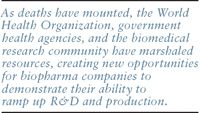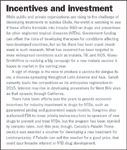Ebola Crisis Challenges Pharma R&D
Pharmaceutical Executive
Companies gain support-and pressure-to deliver new treatments for spreading outbreak.
Up until a few months ago, there was little industry interest or public support for developing vaccines and treatments to combat the Ebola virus. Now the rush is on to launch clinical trials of therapies with some potential effectiveness against the disease. As deaths have mounted, the World Health Organization (WHO), government health agencies and the biomedical research community have marshaled resources, creating new opportunities for biopharma companies to demonstrate their ability to ramp up R&D and production. Big Pharma companies such as GlaxoSmithKline and Johnson & Johnson stand to gain public recognition and to bolster global vaccine programs, while tiny biotech firms see stock prices rise, along with government contracts and grants.

Jill Wechsler
The situation also encourages FDA and regulatory authorities to facilitate these efforts by collaborating on testing and production requirements for experimental treatments. FDA recently approved initial trials in humans of two vaccine candidates and previously utilized its Emergency Use Authorization to allow broader use in Africa of a not-yet-approved Ebola diagnostic. The agency also has permitted Tekmira Pharmaceuticals of Vancouver to provide its experimental treatment for emergency care, despite continuing a "partial hold" on its Phase I trial. FDA guidance issued in July on developing drugs for neglected tropical diseases (NTDs) should help sponsors design clinical trials and gain assistance and advice from FDA and other federal agencies.
Boosting research
The U.S. has provided nearly $200 million for Ebola relief efforts on the ground, including some to bolster infectious disease and pathogen research at the National Institute of Allergy & Infectious Disease (NIAID), the Biological Advanced Research and Development Authority (BARDA), and several Department of Defense (DOD) programs to protect against biological threats. Similar amounts have been pledged by the World Bank and the European Union, and the Bill & Melinda Gates Foundation recently contributed $50 million to emergency efforts, including Ebola therapy development.

An important step in spurring Ebola drug research was WHO's decision in August that it is ethical to use unproven therapies to help contain the spreading outbreak. WHO further assembled some 200 movers and shakers of the biomedical research and public health community in Geneva last month for a "consultation" to identify the most promising treatments for further testing and development. Vaccine industry executives and biotech hopefuls joined the discussion about resources available to conduct clinical trials and the feasibility of production scale-up. The group examined the ethics of conducting clinical trials, the need for regulatory cooperation and flexibility, and potential hurdles to distribution and administration of new treatments.
Agreement on which vaccines and antivirals had sufficient data on immune response in primates to warrant initial testing in humans has generated a race between big and small vaccine makers to demonstrate safety and efficacy for their respective vaccines. NIAID quickly obtained FDA approval to launch early studies in healthy volunteers of the vaccine developed by GSK's Okairos unit in Switzerland. A $4.6 million grant from the Wellcome Trust and British health agencies will support additional studies in Europe and Africa, plus production of some 10,000 units for broader administration to healthcare workers and at-risk populations if studies are successful.
FDA also authorized initial human testing of the VSV-EBOV vaccine, developed by NewLink Genetics of Ames Iowa, using a platform licensed from the Public Health Agency of Canada. That set the stage for the Walter Reed Army Institute of Research to initiate Phase I trials. In addition, Johnson & Johnson hopes to launch clinical trials of an Ebola vaccine formulated by its Crucell vaccines unit (Netherlands) in collaboration with NIAID and Bavarian Nordic (Denmark). J&J says it could produce some 7,000 doses in six months if wider distribution is warranted.

Incentives and investment
The WHO consultation further identified a number of antivirals with potential to treat Ebola, some developed as protections against influenza and other viruses. BioCryst Pharmaceuticals, for example, has support from NIAID for primate testing and Phase I safety studies of a small molecule injectable for hemorrhagic fever viruses. A subsidiary of Japan's Fujifilm plans to test its new oral influenza treatment favipiravir for Ebola treatment. The Japanese government authorized stockpiling of the drug for pandemic flu earlier this year and has offered to make thousands of doses available to Ebola victims. Boston-based MediVector has been conducting Phase III trials in the U.S. for influenza protection, and DOD is supporting additional testing of favipiravir against Ebola.
Most discussed is the ZMapp cocktail of three monoclonal antibodies from Mapp Biopharmaceutical of San Diego, which made headlines when two American health workers infected by Ebola recovered following ZMapp administration. Last month, BARDA awarded an additional $25 million contract to Mapp to accelerate ZMapp testing and production. The drug comes from tobacco leaves in a process for antibody production operated by Kentucky BioProcessing (a unit of tobacco giant Reynolds American) with support from DOD. There has been broad interest in using tobacco and other plants to produce vaccines and biologics, and the excitement over ZMapp creates an opportunity to evaluate biopharming capabilities further.
Expanded production of experimental Ebola therapies could utilize three new BARDA Centers for Innovation in Advanced Development and Manufacturing, which were launched in 2012 to provide more flexible, modern vaccine manufacturing technologies able to produce 150 million doses in 12 weeks in the event of an influenza pandemic. BARDA's fill-finish manufacturing network also could be tapped to support production of Ebola vaccines and injectibles. These programs and other medical countermeasure initiatives supported by HHS, DOD, and other federal agencies will be discussed at the annual BARDA Industry Day, Oct. 15-17, in Washington, D.C.

Jill Wechsler is Pharmaceutical Executive's Washington correspondent. She can be reached at jwechsler@advanstar.com.

Addressing Disparities in Psoriasis Trials: Takeda's Strategies for Inclusivity in Clinical Research
April 14th 2025LaShell Robinson, Head of Global Feasibility and Trial Equity at Takeda, speaks about the company's strategies to engage patients in underrepresented populations in its phase III psoriasis trials.
Beyond the Prescription: Pharma's Role in Digital Health Conversations
April 1st 2025Join us for an insightful conversation with Jennifer Harakal, Head of Regulatory Affairs at Canopy Life Sciences, as we unpack the evolving intersection of social media and healthcare decisions. Discover how pharmaceutical companies can navigate regulatory challenges while meaningfully engaging with consumers in digital spaces. Jennifer shares expert strategies for responsible marketing, working with influencers, and creating educational content that bridges the gap between patients and healthcare providers. A must-listen for pharma marketers looking to build trust and compliance in today's social media landscape.